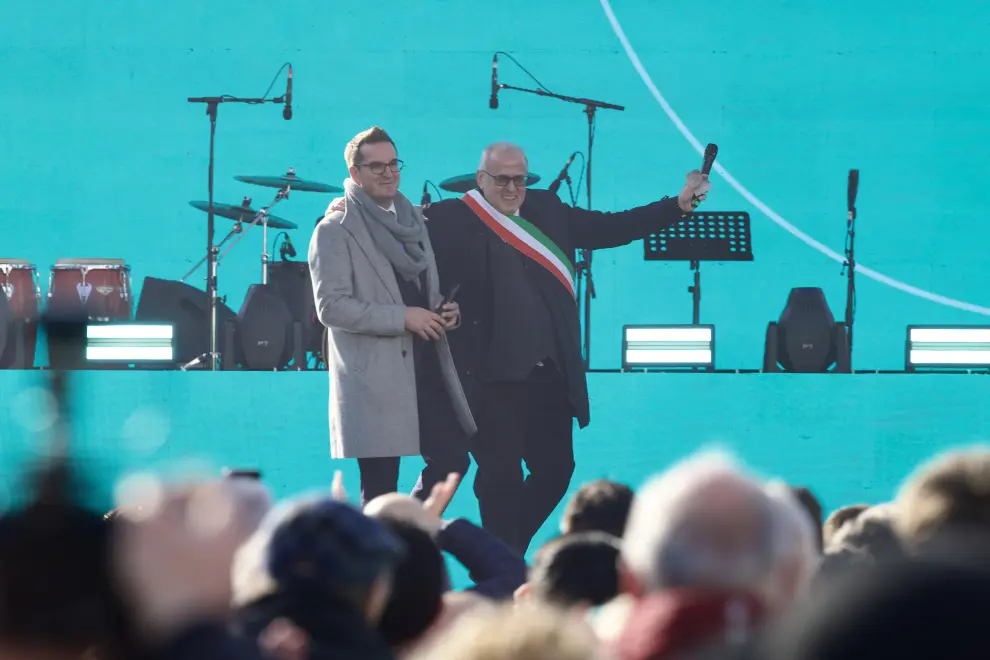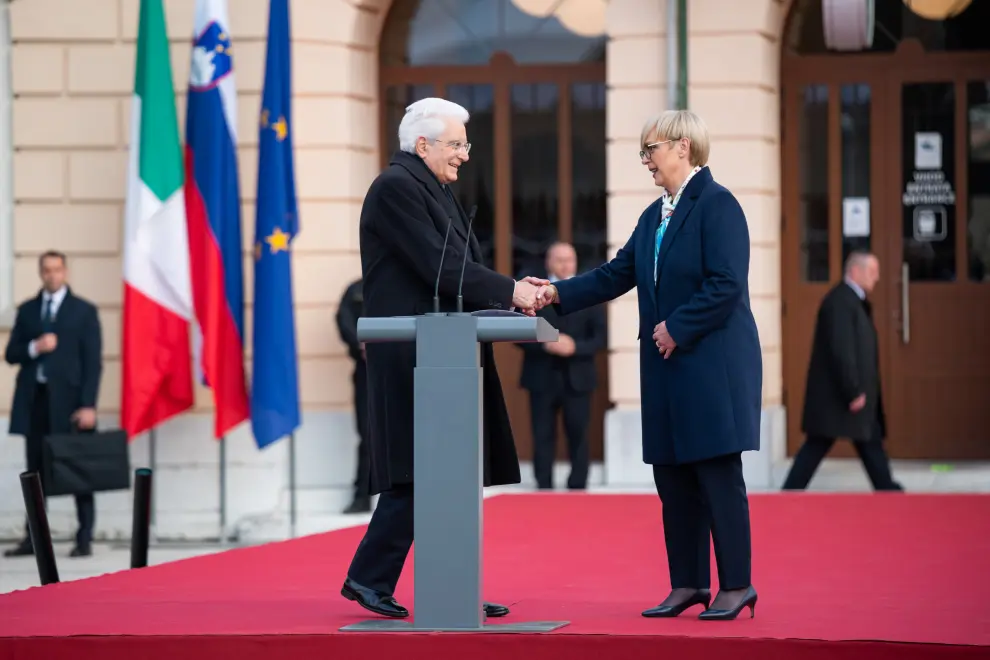Nova Gorica and Gorizia reunite for European Capital of Culture
Two cities that used to be split by a hard border have become united in a celebration of shared culture as Nova Gorica in Slovenia and neighbouring Gorizia in Italy officially kicked off a year of events as the first ever transnational European Capital of Culture.
The day-long event series titled From Station to Station on 8 February, kicked off with dancers, percussionists, folk music groups, brass bands and carnival groups setting out from the Gorizia train station for a five-hour procession to the centre of Nova Gorica.
The colourful parade featured not just performers but people from both sides of the border, including many members of the Slovenian minority in Italy, a sizeable and vibrant community that, along with the Italian minority in Slovenia, has long acted as a bridge between the two nations and cultures.
The European Capital of Culture is important for the minority because "we feel it as a connection to the motherland that is typically not there," Martina, a teacher at Slovenian primary school in Gorizia, told the Slovenian Press Agency.
"It is truly a one-of-a-kind event. After such a long time, during which there were two world wars, it finally brings Italy and Slovenia together," added Ljuba Legiša, a member of a Slovenian folk dance group from Trieste, an Italian city that is home to a large Slovenian community.
As part of the ceremony, the Newspaper Sphere, a famous work of art by the Italian artist Michelangelo Pistoletto consisting of a giant ball covered in newspaper cut-outs, was carried across the border as a symbol of peace.
Four folk dance groups, two Slovenian, one Serbian and one Macedonian, joined the parade at the Nova Gorica Local Government building, and 200 singers from choirs from the region sang together on the stairs of the Eda Centre, performing the classic Slovenian pop tune Dan Ljubezni (Day of Love) standing under banners in the emerald hue of the bordering River Soča, which is also the official colour of the European Capital of Culture.
The transnational event is seen not just by locals but also by local officials as a landmark that has brought the cities, already strongly linked by commercial and cultural ties, even closer together.
Nova Gorica Mayor Samo Turel expressed the hope that Nova Gorica and Gorizia will forge even closer ties and better understand each other. In uncertain times, the message of the project is all the more important, as it shows that cooperation is possible despite a tragic history, he said.
"Today we are making history because we managed to unite, because we managed to bring down the border. Things work best together," said Gorizia Mayor Rodolfo Ziberna.
Nova Gorica Mayor Samo Turel (left) and Gorizia Mayor Rodolfo Ziberna (right) at the opening ceremony of the 2025 European Capital of Culture 2025. Photo: Nebojša Tejić/STA
The cross-border parade was conceived as a tribute to the Friendship March, a recreational event held in the 1970s and 1980s that later got the moniker "Schengen before Schengen" because it brought the two cities together at a time when they were still separated by barbed wire.
It marked the beginning of year-long festivities that the people hope will not just attract visitors but also foster dialogue about what life along the border may look like.
"We want global politicians to look at the parade as well, to see how it is possible to coexist and share things good and bad, using words rather than weapons to have a conversation," said Valter, a Nova Gorica native.
Cooperation and understanding between cultures and nations was a thread running through the numerous speeches and performances that the two cities hosted throughout the day, including a high-level ceremony in Europe Square, which is intersected by the border and used to be divided by barbed wire, but, recently renovated, is now a symbol of cooperation.
Slovenian President Nataša Pirc Musar said it was touching that on Slovenian Culture Day, a national holiday celebrated on 8 February, and in Europe Square, the place which hosted the main ceremony when Slovenia joined the EU more than two decades ago, "we are opening the European Capital of Culture together with our neighbours and friends from Italy."
Pirc Musar described the "day that will forever remain in our hearts" as a historical day, the culmination of a century-old vision of peace, freedom, neighbourly relations and mutual respect, friendship and love.
Italian President Sergio Mattarella similarly said the opening was a historical day for both cities, both countries and the European Union as a whole. He said the project had deep roots in the long history of friendship and reconciliation that Slovenia and Italy are rightfully proud of.
Slovenian President Nataša Pirc Musar (right) and Italian President Sergio Mattarella (left) at the official opening ceremony of the 2025 European Capital of Culture in Europe Square. Photo: Nebojša Tejić/STA
The opening celebrations culminated with an artistic spectacle in Edvard Kardelj Square in the centre of Nova Gorica that featured performances by Slovenian stars as well as Italian performers highlighting the shared culture and history.
The musical underpinning was provided by Insieme, a song with which Italian singer Toto Cotugno won the Eurovision in 1990, parts of which were performed by brass bands, opera singers and the RTV Slovenija Symphony Orchestra.
Pianists Alexander Gadjev and Giuseppe Guarrera joined forces, while Boštjan Gombač, a multi-instrumentalist, acted as a station manager of sorts with performances on a replica of the Divje Babe flute, a bear bone with spaced holes from 50,000-60,000 years ago that is believed to be the oldest instrument in the world.
Through December, Nova Gorica and Gorizia will see around 400 events in the official programme and just as many accompanying events, but the two cities also hope that the European Capital of Culture will leave a lasting mark on the region after the events end.
One of the main projects will thus be a permanent exhibition on the complexities of 20th-century history. Called the European Platform for Interpretation of the 20th Century (EPIC), it will be displayed in a former warehouse next to the Nova Gorica railway station, shedding light on the area's multiculturalism and troubled past.




